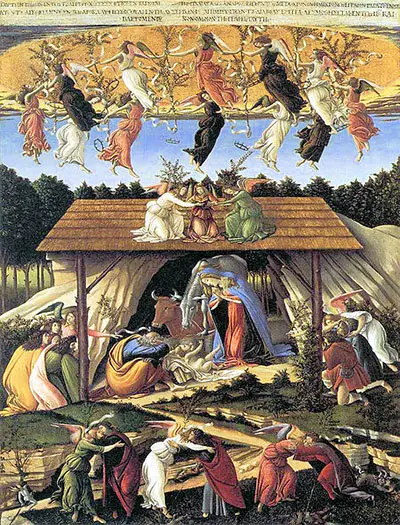 Buy Art Prints Now
Buy Art Prints Nowfrom Amazon
* As an Amazon Associate, and partner with Google Adsense and Ezoic, I earn from qualifying purchases.
Sandro Botticelli (1445/6-1510), an Italian Renaissance master painter from Florence, created The Mystical Nativity circa 1500-1501.
This oil on canvas portrayal of Christ’s birth is currently housed at the National Gallery in London and is the only work to bear his signature.
Both the figures of Mary and Christ are presented on a slightly larger scale than the others thus emphasizing their importance in the scene. Depicted is a moment of both elation and trouble.
The angels, representative of faith, hope, and charity, dance in joyous celebration, replete with olive branches, above the mother and babe. Below them the three kings, strangely without gifts, bend in worship.
More angels are found embracing those who have come to pay homage to the Christ child and others hold scrolls proclaiming “peace on earth” for those who express goodwill. Demons flee the scene in despair.
Many scholars believe that Botticelli felt he was living during the Tribulation, a time of great unrest. Hardship, famine, and war were presumed to immediately precede the second coming of Christ.
Such a gloomy prediction seems to explain the rather dark inscription found at the top of the painting which describes the imminent arrival of the devil. In these ways, some scholars believe that this painting also echoes earlier works of other artists which predict the rapture.
Botticelli was likely influenced by the teachings of an engaging fanatical cleric named Savonarola who arrived in Florence around 1490. Savonarola believed that the world, particularly Florence, was a wicked, corrupt place begging for the judgment of God. His words seemed prophetic when the Italian War of 1494-98 threatened the city. Savonarola helped to end the conflict and became a hero to the Florentine people.
He proclaimed that Florence could become the new holy land if only Florentines would give up their sinful vices and luxuries, including their art. It seems that Botticelli himself may have even participated in the destruction of art.
By 1498, this charismatic leader had procured powerful enemies who managed to have him executed. Several scholars believe that he is one of the three men depicted at the bottom of the painting. Botticelli’s ironic tribute to Savonarola may have been the artist’s only way to immortalize his hero.
Following Botticelli’s death in 1510, The Mystical Nativity remained hidden for three hundred years. It was bought cheaply by a rich Englishman named William Young Ottley who displayed it in his impressive, private collection. The painting remains in London to this day.




